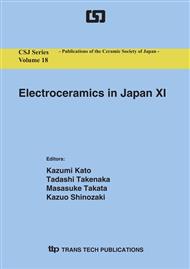p.241
p.245
p.251
p.257
p.261
p.265
p.269
p.273
p.277
Temperature Dependence of Cathodoluminescence for AlN Ceramics Sintered with Ca3Al2O6
Abstract:
Aluminum nitride ceramics were sintered with 1.0 and 4.8 mass% Ca3Al2O6 (C3A) as a sintering additive. Temperature dependence of cathodoluminescence (CL) for the ceramics was investigated in order to obtain information on lattice defects. The CL peak intensity at 3.5 eV in the ceramics sintered with 1.0 mass% C3A decreased with increasing temperature, so called thermal quenching. The maximum CL peak intensity of the ceramics sintered with 4.8 mass% C3A was much lower than that with 1.0 mass% C3A, reflecting that the oxygen-induced defect density dramatically decreased with increasing amount of C3A. In case of the ceramics sintered with 4.8 mass% C3A, the CL peak intensity at 3.4 eV showed the thermal quenching in the range of 130 - 350 K, whereas in the range of 80 - 130 K and 350 - 475 K, it increased with increasing temperature, so called “negative” thermal quenching. From the results, we suggest a presence of at least two trapping levels in the ceramics sintered with C3A.
Info:
Periodical:
Pages:
261-264
Citation:
Online since:
September 2008
Price:
Сopyright:
© 2009 Trans Tech Publications Ltd. All Rights Reserved
Share:
Citation:


